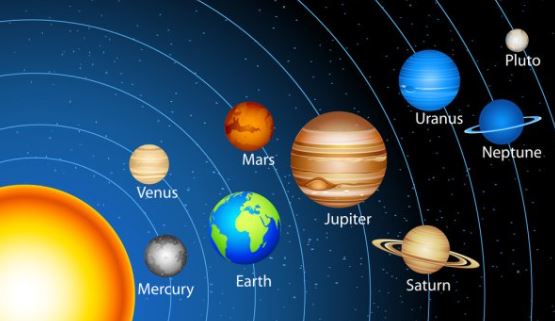Sun Mercury Venus Earth Mars Jupiter Saturn Uranus Neptune all are the part of Solar system
The Solar System :-
Our solar world is full of wonders. A large number of planets, moons, asteroids, comets, minor planets etc are present in the solar system and they orbit the Sun.
Sun :-
The sun is a star which is closest to the Earth. All the planets in our solar system orbit around it. The sun is an important source of energy for the Earth as it provides warmth as well as solar energy. The sun mostly consists of hydrogen and helium along with carbon, oxygen, nitrogen and other gases in small amounts. its surface temperature is 5,778 Kelvin. The temperature is even higher inside the sun. At its core, it can reach 27 Million degrees Fahrenheit! Your may wonder where all this hear comes from. The nuclear fusion that happens in the center of a star releases huge amounts of energy. This energy releases heat and makes the stars extremely hot.
Did your Know :- Kelvin is a unit of measurement that is used by scientists to measure temperature. 5,778 Kelvin is equal to 9,941 degrees Fahrenheit.
Mercury :-
Mercury is the planet closest to the sun and is the quickest to revolve around it. It is a dense planet with a solid iron core and a thick crust. However, Mercury is actually small in size and hence, has a weak gravity. It is not even able to hold an atmosphere! This makes it unable to regulate its temperature which keeps on fluctuating.
Venus :-
Venus is the second planet from the sun and the hottest in our solar system. It is a dry world where all the water has evaporated due to rampant climate change. Venus appears as a bright, beautiful object which can be observed directly at the time of sunrise. for this reason, it is also called the Morning Star.
Earth :-
Earth is the planet where we all live. so far it is believed that earth is the only planet in our solar system that can support life. The Earth is the third planet from the sun. Even though it is one of the closer planets, it is still located 93 million miles away from the sun. Since it is fo far away, it takes the Earth about 365 days to circle all the way around the sun. That is why a year is 365 days long! The Earth not only orbits the sun but also spins on its own axis. The cycle of day and night is maintained because of this rotation.
Mars :-
Mars, which is red in color is the fourth planet in the Solar System and stands second among the smallest planets. The currently desolate Mars have shown signs of the availability of liquid water and atmosphere at same point of time, which indicates the possibility of existence in this planet. Therefore, Mars is a planet similar to teh Earth. the planet Mars has the greatest number of high mountains and deep canyons than any other planet in our solar system.
Jupiter :-
Jupiter is the largest planet in the Solar system, so much so that you can fit 1,321 Earths inside Jupiter. It is made up of gas and is none of the four “gas giants”. Jupiter has 66 moons and one of them, Ganymede, is bigger than Mercury. The distance between Jupiter and the sun is five times the distance between the earth and the sun, and Jupiter takes around 12 years to travel around the sun.
Saturn :-
Saturn is famous for its rings. the rings which were discovered in 1610 by Galileo, are made up of small lumps of ice and dust. The pieces in the rings may be as small as a millimetre or as large as the length of a few metres. Saturn is the second largest planet in the Solar System and is one of the “gas giants” like Jupiter. It takes 29.5 years to travel around the sun.
Uranus :-
Uranus is also classified as a “gas giant”. You can fit 63 planets of the Earth’s size inside Uranus. Uranus takes 84 years to orbit the sun and is the coldest planet with an average temperature of -220 degree. Methane in the upper atmosphere absorbs red light, giving Uranus its blue-green color. The atmosphere consists of various clouds running at constant latitudes.
Neptune :-
Neptune is the planet farthest from the sun. Its distance from the sun is 30 times that of the earth and it takes 165 years to travel around the sun. Neptune is the last of the four “gas giants” and is 58 times the volume of the Earth. Neptune is dark, cold and windy. It is quite similar to Uranus and is made up of a thick mixture of water, ammonia and methane over a solid center which is of the Earth’s size. Its atmosphere is made of hydrogen, helium and methane. The methane gas provides Neptune the same blue color as Uranus. Neptune has six rings, but they are hardly visible.

